Fungal diversity and relationships
1/30
There's no tags or description
Looks like no tags are added yet.
Name | Mastery | Learn | Test | Matching | Spaced |
|---|
No study sessions yet.
31 Terms
Fungal Diversity
The Kingdom Fungi (Eumycota) has multiple phyla including the following:
Basidiomycota
Ascomycota.
How do fungi metabolize?
They are heterotrophs that decompose organic matter (saprotrophs)
Basidiomycota
Example: Agaricus bisporus (common mushroom)
How are bacteria classified?
using 16S rRNA sequencing.
Fungal classification
ITS1 is the region between 18S and 5.8S rRNA.
we can tell phyla apart from the ITS1
Fungal Nutrition
fungi are heterotrophs with absorptive nutrition, they secrete enzymes to break down material and absorb nutrients
due to this they are called saprotrophs
Role in Nutrient Cycling
Fungi convert organic matter to inorganic molecules.
as well Breakdown of dead/decaying material supports ecosystems.
fungi role in gut microbiome
are present in the gut microbiome, but their role is unclear.
Industrial Uses of Fungal Enzymes
Fungi secrete enzymes that can be used commercially.
Used in detergents (e.g., removing grass stains).
Fungal Cell Wall
made up of
Glucans
Chitin
inner membrane
outter membrane
sterols
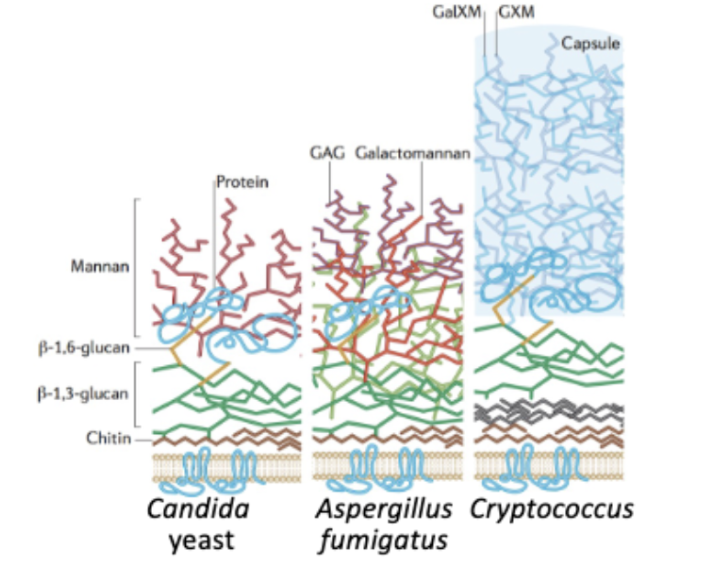
Inner cell wall
Made up of chitin and branched B-1,3

Chitin
rigid polymer only found in fungus
Outter cell wall
Very variable we can see
in yeasts → its comprised of mannan. and mannoproteins
B-1,6-glucan in some cases
Sterol specific to fungi
Ergosterol

Distinctive traits in fungi
Hyphae
Mycelium
Fruiting bodies
Hyphea
most fungi grow as extended multinucleiate cellular filaments called hyphae

Septate hyphae: Have cross-walls separating individual cells.
Non-septate (coenocytic) hyphae: No cross-walls; multinucleate.
Pseudohyphae: Chains of elongated yeast cells that remain attached.
dont need to memorize!
Mycelium
a structure of different hyphae branching, that forms a colony
Spore germination leads to hyphal growth, forming a mycelium.

they can branch to form mushrooms
Fruting bodies
Mycelia can differentiate into fruiting bodies that produce and release spores.
Example: Mushrooms are fruiting bodies of some fungi.
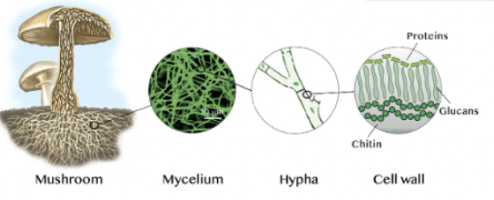
Microfungi
mostly invisibile to naked eye
ex) yeast, mould
Macrofungi
produce easily visible fruiting body
ex) mushrooms
Do all fungi produce spores?
Yes, asexually or sexually
except yeast onyl forms sexual spores
Distinctive features in asexual reproduction
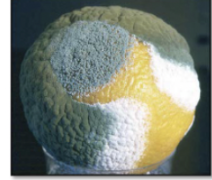
The lighter region represents the mycelium that hasn't developed any fruiting structures yet, located at the outer edge (peripheral zone). As it forms the fruiting body, the color will change. Once the orange drops, the spores will detach and disperse.
exponential growth is limited to the periphera growth zone
Distinctive features in sexual production
Example) Ascomyota
Ascospores form inside a sac-like meiocyte called an ascus, and the sexual fruiting body is called an ascoma.
Hyphae differentiate to form pores, allowing the fungi to spread spores at the interface with the environment.
funghi spreads through pores
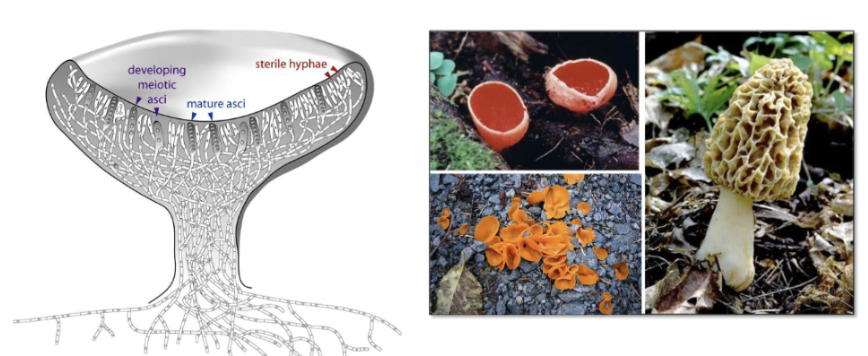
Yeast
unicellular organisms that grow via budding
some can can form hyphae
example) cryptococcus neoformans

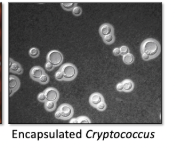
What are shmoos and how do they contribute to yeast reproduction?
Shmoos are cells in yeast that form during sexual reproduction. These cells fuse to create a zygote.
Symbiotic relationship
organisms live with each other in positive or negative relationships.
usually involves 2 symbionts
Symbiotic interactions
Commensalism → on e partner benefits, other is unaffected
Parasitism → one partner benefits, while harming a specific host
Mutualism → each partner gains benefits from the other
Parasitic fungal pathogens
candida
cryptococcus
aspergillus
Mutualism
Mutualism is a relationship where both partner species benefit from each other and may fail to grow independently. In this relationship, the species rely on each other for survival, and one cannot thrive without the other. Mutualism can involve microbial partners alone or with a plant or animal host.
How do genomes change in mutualistic relationships?
In mutualism, the microbial genome often shows degeneration, with a reduction of essential genes for metabolism and protective structures. This means the microbes evolve to depend on each other, and once in the relationship, they cannot survive or grow independently. Examples of such mutualisms include lichens, and mycorrhizae.
Lichens
Lichens are a mutualistic relationship between fungi and photosynthetic algae or cyanobacteria. Neither symbiont can survive independently. The photosynthetic partner provides carbohydrates to the fungi, while the fungi supply water and minerals to the photobiont and offer physical protection. Nutrient exchange occurs at the "photobiont layer." Lichens can grow on various surfaces, such as bark, leaves, and rocks.
